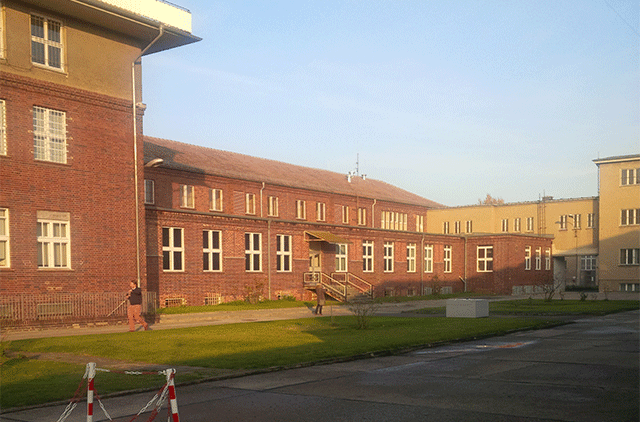
On Sunday, November 9, 2014, it will be a quarter of a century since the Berlin Wall fell. The reunification that followed was a triumph for Germany. Gulf News Senior Associate Editor, Robin Chatterjee, is in Berlin to cover the 25th anniversary of that historical event.
November 9, 11.14am in Berlin (2.14pm in Dubai): The ceremony at the Chapel Of Reconciliation is now over and German Chancellor Angela Merkel, along with other high ranking officials and chaplains, are greeting the local population.
The service at the chapel was held to mark the fall of the Berlin Wall.
In a few minutes, Merkel and other officials will be lighting candles at the National Memorial for the Victims of the Berlin Wall.
A walk along the former border wall to the Visitor Centre will then take place.
Earlier, the day's programme commenced with a ceremony by the Hinterland Wall. This began with a trumpet call and a welcome by the Director of the Berlin Wall Memorial Dr. Axel Klausmeier.
Roses were then laid along the Hinterland Wall with Merkel in attendance.
An official opening of the new permanent exhibition in the Documentation Centre of the Berlin Wall Memorial will take place in a few minutes.
Merkel is then scheduled to attend the Konserthaus in the Berlin Senate Administration, along with Berlin Mayor Klaus Wowereit at rouhgly 6:40pm (UAE time).
A ceremony to mark the 25th anniversary of the fall of the Wall then begins at 7pm with an opening by Ivan Fischer and his orchestra.
This will be followed by a film clip, speech by the Mayor of Berlin, interviews with civil rights activists, a short speech by Martin Schulz, president of the European Parliament and a musical programme.
November 9, 11am in Berlin (2pm in Dubai): The slightly cloudy and cold weather has not deterred Berliners and Germans from all parts of the country from descending into the city.
The officials have got their formalities to attend to - and they have already begun according to a water-tight programme drafted by the organisers - but the common folk have only one priority: to get to the select venues in time before the people's party begins.
The places to set up camp are obviously the Brandenburg Gate; Potsdamer Platz, Bernauer Strasse by the Wall Memorial, or Bornholmer Strasse, the place where the Wall first opened up.
The people's party begins at approximately 3pm (UAE time).
There are a number of acts scheduled to perform. These include noted musician Peter Gabriel (9:05pm) and he will be performing the official version of 'Heroes'. Gabriel then kicks off a tour of Europe beginning with a performance in Brussels, Belgium.
Other performances will come from a youth band called Otto Normal, there will be talks with civil rights activists. The official opening of the border of lights "Balloons of Freedom" will be released by Berlin's popular mayor Klaus Wowereit.
At 10.20, Staatskapelle with Daniel Barenboim will perform Beethoven's Ninth Symphony (Fourth Movement). Musicians Udo Lindenberg and Paul kalkbrenner will then close the party with consecutive performances.
Tourist attraction was once border between democracy and communism
November 8, 4.25pm: It was surreal to see people from the Eastern and Western parts of Berlin walking across what was once a political and physical border that separated two cities and two countries with contrasting ideologies.
The western part of Berlin continues to demonstrate the benefits of freedom, democracy and capitalism. Posters of Che Guevera and Bob Marley, both of whom embody the tenets of freedom in their respective fields, are sold along the streets in shops that also stock Russian war memorabilia.
Scroll down to earlier post for pictures from Checkpoint Charlie
Checkpoint Charlie, a name given by the Allies, is the best known Berlin Wall crossing between East and West during the famous Cold War era. It was set up in 1961 to prohibit eastern bloc emigration to the West.
Many men and women lost their lives in an attempt to make the dash to freedom and democracy and their tales are chronicled in German history.
Today, Checkpoint Charlie stands as a tourist attraction trying to generate revenue on both sides with exhibitions and museums by showing off the ills of a once oppressive East German regime and the lure of the democratic West.
The area is still highlighted with signposts announcing the departure from the west to the east and vice versa.
On the western side, young German youth dressed as American soldiers, pose for photographs with tourists. The first sign of capitalism is also present – McDonald’s.
On the eastern part lies a group of Trabi cars, which are now a collector’s item, and a Trabi museum. The presence of building with no windows that face the west is also a cautionary tale on the one dimensional attitude of communism.
The mood on the eastern part of the city is cold and sober. There is more excitement and optimism just a few feet across the once celebrated border. It is almost as if mankind wishes to stay from an area that echoes the excesses of the past.
Former inmate gives insight into life in a Stasi prison
November 8, 3.15pm: A tour of the former Stasi prison at Gedentskatte in the quiet industrial suburb of Hohenschonhausen in East Berlin laid bare the excesses committed by the Stasi, the secret service arm of the East German Ministry of State Security.
The complex has been a memorial since 1994 and currently receives an annual contribution, by virtue of being assigned as a foundation, by the Federal Government and the Berlin state government.
The prison endeavours to keep itself relevant in the eyes of the public – German and tourists – by organising exhibitions, events and publications on the evils of the former communist dictatorship which saw the imprisonment and deaths of thousands of suspects and prisoners.
The aim is to create public awareness but the truth is an uncomfortable one albeit necessary if one wants to get eyewitness and archived material of how the GDR’s infamous political system worked.
CLICK HERE FOR MORE PICTURES FROM THE PRISON TOUR
Most of the buildings, offices, interrogation rooms, various kinds of cells have been kept intact. It gives the impression that they are still operational. The air still gives off the odour of burnt brown coal which was used for heating during the winter.
Cigarette smoke still hangs in the air. Some of the walls are caked with the remnants of tobacco in the interrogation rooms where suspects were subjected to hours and days of relentless psychological pressure and interrogation before eventually confessing to crimes they did not commit.
There different kinds of cells in this prison complex. The most infamous one, however, is located at the bottom of the building where there is no natural light. Prisoners who have spent time there call it ‘the submarine’.
There is another wing in Gedenkstatte which operates on the ‘traffic light system’ where prisoners movements along the corridors were controlled according to the ‘red light, green light’ procedures.
Our guide Cliewe Juritza was a former prisoner in East Germany. He was captured by the Stasi because he was trying to defect. “Nobody has been able to predict the calibre of the wall,” he said.
“I was in prison for a year after which I was sent off to West Germany following the payment of a ransom of 96,000 deutschmark, equivalent to 70,000 euros [Dh320,000].”
Juritza still carries the scars of the past. It is evident in the way he looks, talks and describes events. He has not been able to shake off his East German roots which took form in an era of cruelty, ambiguity and control of a human being’s mind and body.
Tours of the prison are usually led by former inmates, who provide first-hand details on prison conditions and the interrogation methods employed by the Stasi.
Pictures from Checkpoint Charlie
A building that once overlooked the West from East Berlin, with no windows to stop people looking out.
The Trabi, a popular East German car.
A McDonald's store is one of the first signs of capitalism in Berlin.
Items on sale at Checkpoint Charlie on Friday.
Fancy a bite? Typical German food on sale.
A street scene in Berlin on Friday.
A Checkpoint Charlie souvenir shop.
The US side of Checkpoint Charlie, in West Berlin.
Young men pose an American soldiers.
Tourists take pictures of the recreated scene.
Entry into East Berlin and the world of Communism.
Attractions at the former site of the Berlin Wall.
The accidental opening
12:40pm, UAE time: Speaking to a group of Germans who have descended upon Berlin for the Wall's 25th anniversary festivities, I was surprised to know that the Wall almost did not fall on November 9.
A certain gentleman named Gunther Schabowski, the Central Committee spokesman for the SED, stumbled clumsily following a question from a reporter called Riccardo Ehrman from Italian news agency ANSA and made history personally.
Apparently, Schabowski was putting the world's media to sleep through a briefing detailing the GDR's new travel regulations. There were rumours that something big was on the cards, but the climax was taking a long time coming.
Some journalists walked out of the hall and just as the briefing was coming to a close, Ehrman took the mike and asked Schabowski pointedly: "When does this come into effect?" This was at 6:57pm. Schabowski's reply was recorded as the most famous stumble in Germany's post-war history. "It begins, to the best of my knowledge.....ummmm....straight away, immediately."
At 7:02 Reuters broke the flash reporting: "Departure via all East German border crossings begins immediately."
Minutes after that, a sea of humanity were already gathering around the designated borders that separated two countries. Schabowski's reply had inadvertently managed to open the border.
Who was doing what on the day the Berlin Wall fell 25 years ago?
12:16pm, UAE time: The West German chancellor Helmut Kohl was on a state visit to Warsaw. The Bundestag was in session in Bonn. Soccer fans were preparing for the next round of the German Cup where Stuttgart was to face German Munich.
Berlin was getting ready for parties: the awarding of the Golden Wheel for the best car of the year and German Chancellor Angela Merkel was preparing to go to the spa in East Germany followed by a visit to the pub. Merkel who was then working at the Academy of the Sciences and Humanities as a physicist had, according to records, also planned to visit the local pub that evening.
A small luxury that she allowed herself after spa treatments. At around 6:57pm that evening the Wall was history. All programmes had been cancelled. Merkel, who was ambitious enough to ring her mother and tell her that "if the Wall falls we'll go eat oysters at the Kempinski Hotel in West Berlin," had to reschedule that programme as well.
She went to the Bornholmer Strasse border crossing and at 7am the next day dutifully went to work. 16 years later she became Chancellor of Germany.












